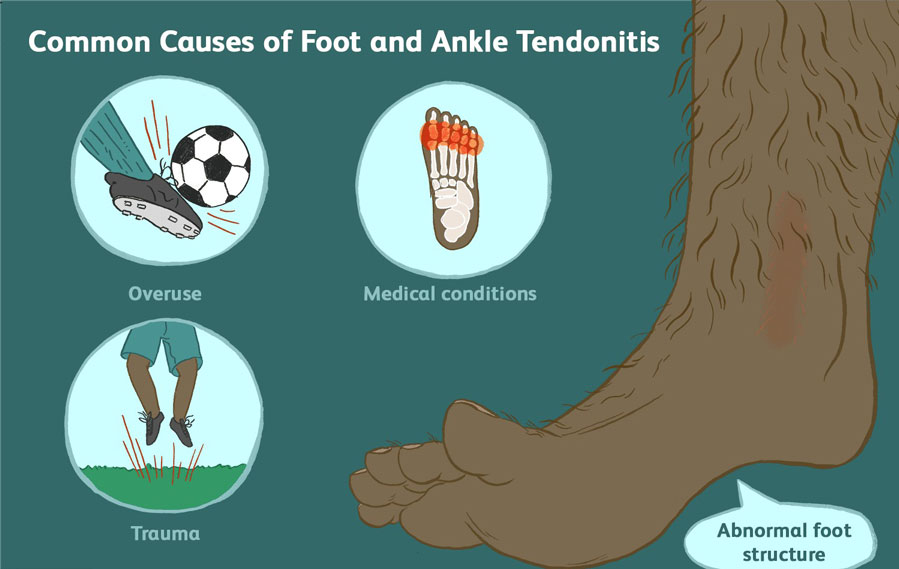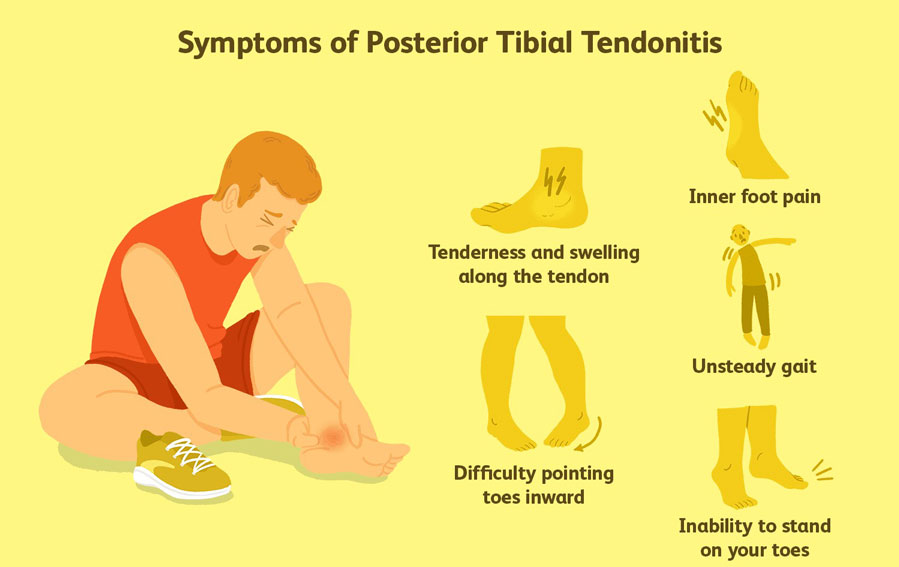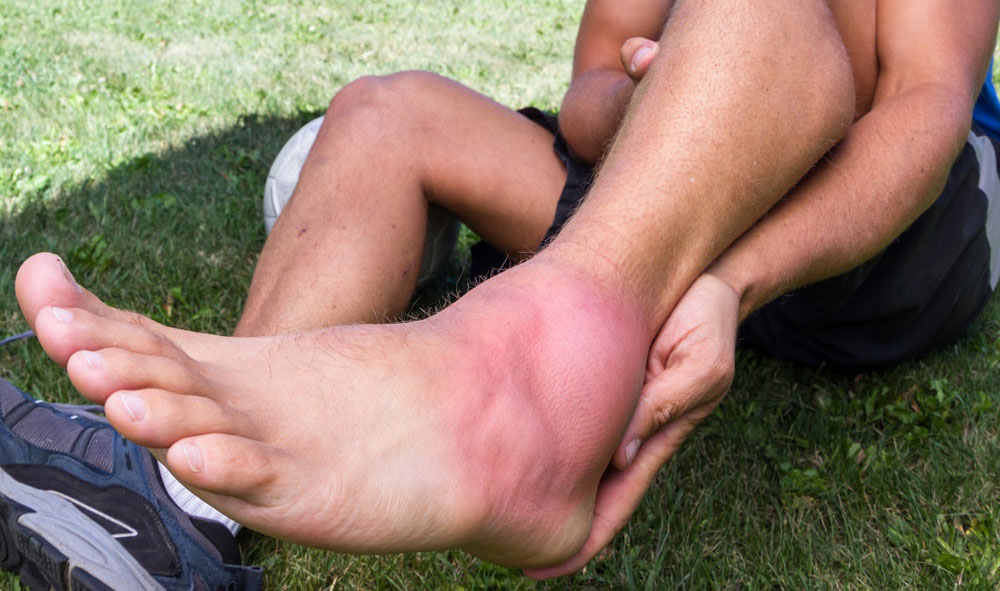FOOT AND ANKLE TENDONITIS
Your feet and ankle bear your complete bodyweight. Feet and ankle are held together by dozens of tendons and ligaments. Tendonitis is a common reason for visits to the podiatrist. The pain tendonitis causes can force you off your feet.
Tendons and ligaments are strong, fibrous bands of tissue connecting the leg, foot, and bone to muscle. These would give you the power to move your feet. Overuse and inflammation can trigger tendonitis around tendons causing pain. This pain can make walking and standing impossible, and severe cases can cause instability and decreased mobility.
Tendonitis affects different parts of your foot and ankle including:
- Back of the ankle or heel extending till calf muscle known as Achilles tendonitis
- The inner side of the ankle or heel is known as Posterior tibial tendonitis.
- The outer side of the ankle or heel is known as Peroneal tendonitis.
- The top of the foot is known as Extensor tendonitis. This is a rare kind of tendonitis.
- Let’s learn more about the cause of tendonitis, when to see your podiatrist, and how to prevent it.

CAUSE OF FOOT AND ANKLE TENDONITIS
Tendonitis may be caused by various reasons, among which some can be controlled. The foot structure and certain health conditions are not under our control.
The main reason for triggering inflammation of tendons include:
- Overuse: Inflammation and pain of tendons are commonly caused by overuse. This would stretch the tendon too far and might lead to wear and tear. This can be caused when you start walking, running, or playing sports often or more intensely.
- Foot structure: Abnormal foot structures such as flat feet or high arches can put stress on tendons. This can cause some muscles to be out of balance.
- Trauma: Any foot or ankle injury such as sprains and fractures can cause tendonitis. This kind of trauma might happen with sudden, powerful motions like jumping. It can also occur if your foot constantly rubs against your shoe. These kinds of injuries most often are located at the top of the foot or heel.
- Medical conditions: Some medical conditions such as rheumatoid arthritis, gout, and spondyloarthropathy can cause inflammation that can lead to tendonitis. These medical conditions can cause Achilles tendonitis or posterior tibial tendonitis.

SYMPTOMS OF FOOT AND ANKLE TENDONITIS
Pain in the foot or ankle is the initial symptom of tendonitis. You may even feel pain when you start an activity such as walking or getting up. The pain may subside but return as you continue to do the activity. Pain may be accompanied by swelling in the affected area such as the foot or ankle. The swelling may worsen when you use, move, or stretch the affected tendon.
You should seek medical care if you notice other symptoms such as:
- Stiffness
- Discoloration
- Redness
- Warmth
- Tenderness
- Throbbing and
- Looseness of the joint.
You are at a high risk of developing tendonitis in the foot or ankle if:
- You are involved in sports that require repetitive movement.
- You are a runner.
- You are over 40. Men are more prone to tendonitis than females.
- If you are overweight.
- If you wear worn-out shoes that do not support the feet or ankle.
- If you have previous injuries of the tendons in the foot or ankle.

DIAGNOSIS OF FOOT AND ANKLE TENDONITIS
Our expert doctors would first look for signs of tenderness in the tendon of the affected area along with weakness while moving the foot and ankle. They would take your medical history into account and may order imaging tests such as X-rays or a magnetic resonance imaging (MRI) scan. These tests help in determining if you have a broken bone, a build-up of calcium in the tendon or tendon calcification, swelling near the tendon sheath, or if your tendon has torn.
Our experts might also get the ultrasound done of the affected area. This would help them look closely at all the soft tissues in the foot and ankle, including nerves, tendons, muscles, and ligaments. A proper diagnosis would help our expert podiatrist to develop a personalized treatment plan.
TREATMENT OF FOOT AND ANKLE TENDONITIS
Initially, the podiatrist would focus on conservative treatment methods involving non-invasive therapies. Resting the affected area is the basic practice to let the body heal the injured or torn tendons. This usually would take about a few weeks to months. Generally, you may be able to treat tendonitis at home. But if it doesn’t get better within 2-3 weeks, you should see a healthcare provider or podiatrist.
The treatment plan would include:
Self-care: RICE therapy involving rest, ice, compression, and elevation helps in providing maximum benefit initially. The podiatrist would advise:
- Limiting your activities.
- Applying cold or ice compression on the affected area to help reduce swelling.
- Providing compression or pressure using gauze bandage wrap or store-bought ankle support. This also helps reduce swelling and restricts
- ankle movement.
- Elevating the affected foot at about the level of your heart.
Medication: Medications are prescribed to reduce pain and swelling. These are helpful when pain and swelling do not get better with home care, or after resting. Over-the-counter medicines or Nonsteroidal anti-inflammatory drugs are prescribed by healthcare providers to ease off pain and swelling.
Orthotics: These include shoe recommendations by podiatrists such as arch supports or inserts and prescription braces. Orthotics help in decreasing your pain and improve your mobility.
Exercise: Regular, gentle exercises help to loosen up muscles and tendons. This would get your foot moving normally again and reduce pain.
Physical Therapy: Stretching and strengthening exercises can help reduce the stress on the affected tendon.
Surgery: If the home treatment and non-invasive therapies do not work, the doctor would recommend surgery. Tendon repair surgery involves removing the damaged tendon by making a small incision in the area above the affected tendon. The surgeon may take a tendon from another area of the body and graft it to the damaged tendon. This would strengthen and repair the weak tendon.

PREVENTION OF FOOT AND ANKLE TENDONITIS
It is important to prevent risk factors that are under control such as sports activities and accidental trauma. Some of the other factors that can be prevented are:
- Avoid injury from sports by following proper instructions and physical training.
- Stretching before working out.
- Using ankle bracing or ankle taping.
OUTLOOK
Tendonitis is a common problem among runners, people involved in sports, injury, trauma, foot problems, or suffering from certain medical conditions. Resting is the initial treatment along stretching your muscles before exercise is a good way to prevent tendonitis. Using proper shoes with adequate support and increasing your activity level slowly can also help prevent tendonitis.
If you or anyone you know is suffering from pain in your foot and ankle, our expert providers at Specialty Care Clinics will take care of your health and help you recover.
Call us on (469) 545-9983 to book an appointment with our specialists.
